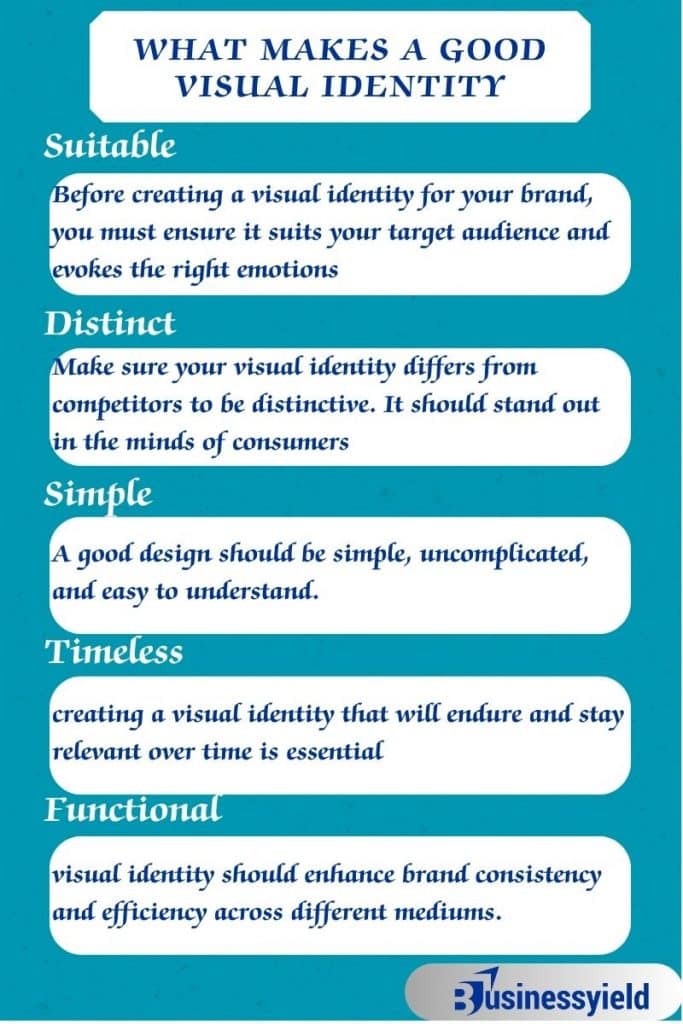We build an experience that reflects a purpose when we create a brand. Visual identity plays a big role in the brand experience. Colors, graphics, and fonts turn brand ideas into visual identities that can be recognized. When a brand is established, it needs a recognizable identity that the audience can discern. This acknowledgment comes with consistency; your brand needs a solid visual identity system to achieve that.
As a business writer, I recall one project where I collaborated with a well-established company to refresh the brand image. During this project, I discovered that the company’s existing visual identity does not connect to its target audience. To evoke the audience’s desires again, we worked closely to develop a modern color palette, typography, and graphic elements that agree with their core values. After these efforts, we created a well-received new identity and boosted brand recognition and engagement. I learned the importance of collaboration between writers, designers, and brand strategists in creating a cohesive brand experience. Furthermore, I will walk you through the meaning of a brand’s visual identity, its examples, and visual identity vs brand identity.
Key Points
- Visual identity is a guide that presents the complete visual experiences of a brand, including color, photography, texture, videography, and more.
- A brand’s identity is a testament to recognition and presence that helps you build a brand identity, include brand identity examples, and summarize the brand style guide, core values, and brand promise through a visible medium.
- Visual identity vs brand identity means the difference between the two. Brand identity is the personality of your business, while visual identity is the visible expression of that personality.
- To create a strong visual identity, ensure that you use your brand identity, know your audience, understand your brand purpose, adapt your assets, and stay consistent.
- Editor X, Celtra, MailChimp, and Spotify are examples of brands with great visual identities.
Visual Identity
Visual identity is a guide that presents the complete visual experiences of a brand, including color, photography, texture, videography, and more. It aims to convey the brand clearly to internal design stakeholders so that they can consistently communicate the brand to the audience.
Some time ago, I was privileged to work with the Hopeful Hearts Foundation, a non-profit organization that wanted to refresh its visual identity. They wanted an identity conveying their missions and values to donors and volunteers. My team and I created a new identity with color schemes, typography, imagery, storytelling campaigns, and website content. This led to increased engagement and support for their cause. This experience taught me about visual identity’s impact on brand storytelling and audience connection.
In addition, visual identity is a clear brand presentation, starting from the logo and color to the website and design of physical stores. It is everything visible that has a connection to a company. Visual identity consists of these elements:
- Graphics
- Logo
- Color pallet
- Animation
- Buttons
- Imagery
- Store design
- Uniform
- Packaging
- Billboards
- Brochures
- Digital and print ads
Read Also: A Comprehensive Guide to Branding Services for Businesses Looking to Stand Out
Visual Identity of a Brand
A brand’s visual identity is a collection of visual elements that represent and differentiate the brand. The visible face of a brand helps customers identify a brand by combining each branding asset into a unified aesthetic. Furthermore, a brand’s identity is a testament to recognition and presence that helps you build a brand identity, include brand identity examples, and summarize the brand style guide, core values, and brand promise through a visible medium.
Thus, uniforms and strategic visuals help communicate a strong visual identity and tell your brand story. I once worked closely with a company undergoing a rebranding process. One of the key aspects of the rebranding was the design of new uniforms for the employees. The uniform reflects the company’s professionalism and conveys its brand personality. I saw how colors, logos, and designs were carefully selected to create great uniforms that told a story about the brand.
What Makes a Good Visual Identity

#1. Suitable
Before creating a visual identity for your brand, you must ensure it suits your target audience and evokes the right emotions. In addition, ensure that each visual design associated with your brand is appropriate for a particular person, purpose, or situation.
#2. Distinct
Make sure your visual identity differs from competitors to be distinctive. It should stand out in the minds of consumers. Also, ensure it is recognizable, and the customer remembers it.
#3. Simple
A good design should be simple, uncomplicated, and easy to understand. A company I know initially created a complex logo with intricate details and many colors. They got feedback based on their design from potential customers and internal stakeholders on the logo’s inconsistency in reproducing across various marketing materials. Afterward, the company made its logo simple by choosing a clean, minimal design with a single color and clear, bold typography. This new, simple design is easier for the internal designers to work with and also evident for the target audience.
#4. Timeless
Creating a visual identity that will endure and stay relevant over time is essential. I worked with a company seeking to update its visual design some time ago, and I suggested that the team refine the existing elements for a more timeless look. We did that by simplifying the logo and updating the color palette. In the end, we came up with a modern design that will stay relevant for years to come.
#5. Functional
Always remember that your visual assets will be used across digital, print, and interior spaces, and your visual identity should enhance brand consistency and efficiency across different mediums.
Read Also: BRAND IDENTITY: How To Build a Strong Brand Identity
Visual Identity vs Brand Identity
Visual identity vs brand identity means the difference between the two. Brand identity is the personality of your business, while visual identity is the visible expression of that personality. Visual identity is based on brand elements, such as logos, colors, typography, and imagery. In addition, what you see when you look at a brand is its visual identity, such as Coca-Cola and Nike’s swoosh.
Brand identity is not just visual elements; it includes the values, personality, voice, and emotions your brand wants to evoke in people. It is all about what your brand stands for. So, brand identity vs visual identity is about what you see, like logo, colors, and overall image and personality of the brand.
How to Create a Strong Visual Identity
The following explains how to create a strong visual identity for your brand to stay recognizable and relevant.
#1. Use Your Brand Identity
You should define your brand strategy well because it will help you select a brand identity that merges with your purpose, goals, and values in one place. This guideline will help you choose your visual identity and keep it aligned. One of my most memorable experiences was when I worked with a client struggling to define his brand identity. They had a good purpose and values but were unsure how to translate that into visual representation. Finally, after extensive research and guidance in selecting the right colors, typography, and imagery to represent the brand, we developed a brand that aligned with the brand’s purpose, values, and goals and evoked the interest of its target audience.
#2. Know Your Audience
When you design your visual identity, you must deeply understand your target market to create an appropriate visible language that effectively communicates with your desired audience. Moreover, based on my research on creating a good visual identity, I got a matching response from many brands on understanding and resonating with your target audience. Firstly, you need to develop your buyer personas. Stating their age, gender, income, education, values, beliefs and motivations. Also, create clear guidelines for who your brand is talking to. Afterward, this will help you make good visual identity choices.
#3. Understand Your Brand Purpose
It is essential to know and understand the purpose behind your business, for it will guide you in making the right decisions for your brand in every aspect. It starts with how to design your business card and your logo. A small startup business owner was striving to carve out a niche in the market. He came to me with a foggy understanding of his brand’s purpose. After an in-depth conversation and research, it was clear he did not have a clear direction for his brand’s visual identity. Afterward, I went deeper to learn his brand story, aspirations, and what drove him. With this knowledge, I could see his visual identity, from the business card to crafting a suitable logo. In the end, the brand’s identity became a true reflection of its purpose, which evoked its target audience.
#4. Adapt Your Assets
When optimizing your visuals, you need to know that understanding each medium’s nuances will help you design better and communicate better. Although your brand may have a clear brand style guide, it is vital to understand how to use it. Furthermore, since different designers will work on other assets, they must understand the essential visual design to adapt each asset accordingly. This can be about sizing or resolution for your logo design across various mediums. I suggest you explore some examples of strong brand style guides to understand better.
#5. Stay Consistent
Staying consistent with your brand is essential because it ensures that all branding collateral has a uniform structure. Also, it resonates with customers, stakeholders, and competitors. It keeps loyal customers continuously coming back. Finally, it is a strong foundation your brand can build upon.
BusinessYield Checklist on How to Create a Strong Visual Identity
Visual Identity Example
When designing your brand’s visual representation, focus on visual trends and keep things fresh. Furthermore, I listed some examples of brands with strong visual identities from which you can learn.
#1. Editor X
This platform was built to help designers develop and launch websites, and their visual identity delivers on every front. This brand uses black and white to create a professional appearance that tops off with gradients to emphasize the constantly changing nature of design and the brand’s flexibility.
#2. Celtra
This example of visual identity is a blend of stunning imagery, gradients, and vibrant colors that combine to create a one-of-a-kind design that engages the audience when explaining its subject matter. Additionally, it is unusual, versatile, and creative, making the brand memorable. Also, it communicates its pioneering mentality in the innovative technology space.
#3. Mailchimp
This is another example of a visual identity that proves that you can express your brand’s creativity, artistry, energetic personality, and capacity to change while creating memorable, functional, and recognizable designs.
#4. Spotify
Spotify is another brand that shows an excellent example of visual identity. It has established itself as a household name in the streaming music world. Also, I can attest to its success in many ways, such as its unmistakable visual design and vibrancy. In addition, this platform uses stunning fonts and bold colors to present the brand’s passion, utility, playfulness, and commitment to storytelling through music.
Read Also: NICHE MARKET: Definition & 20 Best Examples Of Niche Market Products
What Is a Strong Visual Identity?
It means that your brand visuals are memorable and distinct, relevant to the target audience, and consistent with all brand personalities and values.
What Is the Impact of Visual Identity?
It helped build trust in brands with its visual communication using elements that create a strong visual representation. Moreover, this helps to create an emotional connection with the audience.
Why Do You Need a Visual Identity?
You need a visual identity to forge an emotional connection with your target audience, and these connections lead to brand loyalty and advocacy. Also, it is necessary to convey the business value and mission at a glance.
What Is the Difference Between Logo and Visual Identity?
A logo helps customers easily recognize the company and its products or services. Also, t helps the customers connect the company with the brand.






